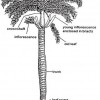 Palms differ greatly from broadleaf (dicot) and coniferous (Gymnosperm) trees in their overall form and external structure (morphology) and in their internal structure (anatomy). Morphology and anatomy determine how palms grow, function, and respond to external and internal stress factors. This publication provides a basic understanding of how palms are constructed. This 4-page fact sheet was written by T. K. Broschat, and published by the UF Department of Environmental Horticulture, May2013.
Palms differ greatly from broadleaf (dicot) and coniferous (Gymnosperm) trees in their overall form and external structure (morphology) and in their internal structure (anatomy). Morphology and anatomy determine how palms grow, function, and respond to external and internal stress factors. This publication provides a basic understanding of how palms are constructed. This 4-page fact sheet was written by T. K. Broschat, and published by the UF Department of Environmental Horticulture, May2013.
http://edis.ifas.ufl.edu/ep473
Category: Environment
Eastern dobsonfly (adult), hellgrammite (larva) Corydalus cornutus (Linnaeus) (Insecta: Megaloptera: Corydalidae: Corydalinae) (EENY414/IN987)
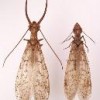 The eastern dobsonfly is one of our largest non-lepidopteran insects. Its larvae, known as hellgrammites, are the top invertebrate predators in rocky streams where they occur. Adult male dobsonflies are particularly spectacular because of their large sickle-shaped mandibles (jaws). This 4-page fact sheet was written by Donald W. Hall, and published by the UF Department of Entomology and Nematology, April 2013.
The eastern dobsonfly is one of our largest non-lepidopteran insects. Its larvae, known as hellgrammites, are the top invertebrate predators in rocky streams where they occur. Adult male dobsonflies are particularly spectacular because of their large sickle-shaped mandibles (jaws). This 4-page fact sheet was written by Donald W. Hall, and published by the UF Department of Entomology and Nematology, April 2013.
http://edis.ifas.ufl.edu/in987
Florida-Friendly Plants for Stormwater Pond Shorelines (ENH1215/EP476)
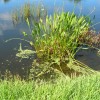 Selecting aquatic and shoreline plants for stormwater ponds is more challenging than selecting plants for a typical landscape. Site conditions can vary greatly and are more difficult to control. For example, water depth sometimes fluctuates widely, creating wet and dry conditions. Water quality varies with rainfall and fertilizer inputs. Steep slopes can make plant establishment and retention difficult. The concept of using the right plant in the right place is particularly important in the shoreline environment because the planting area includes a dry slope and a littoral shelf with shallow and deep water areas. This 4-page fact sheet recommends plants that were selected based on these three questions: 1) What environmental conditions does the plant need to grow? 2) How do you want the plant to function? 3) What do you want the plant to look like? Written by Gail Hansen and Shangchun Hu, and published by the UF Department of Environmental Horticulture, May 2013.
Selecting aquatic and shoreline plants for stormwater ponds is more challenging than selecting plants for a typical landscape. Site conditions can vary greatly and are more difficult to control. For example, water depth sometimes fluctuates widely, creating wet and dry conditions. Water quality varies with rainfall and fertilizer inputs. Steep slopes can make plant establishment and retention difficult. The concept of using the right plant in the right place is particularly important in the shoreline environment because the planting area includes a dry slope and a littoral shelf with shallow and deep water areas. This 4-page fact sheet recommends plants that were selected based on these three questions: 1) What environmental conditions does the plant need to grow? 2) How do you want the plant to function? 3) What do you want the plant to look like? Written by Gail Hansen and Shangchun Hu, and published by the UF Department of Environmental Horticulture, May 2013.
http://edis.ifas.ufl.edu/ep476
A Mealybug Phenacoccus multicerarii Granara de Willink (Hemiptera: Pseudococcidae) (EENY550/IN993)
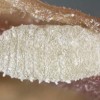 Florida Department of Agriculture and Consumer Services, Division of Plant Industry inspector Lisa Hassell collected the mealybug Phenacoccus multicerarii, a new continental record, from a retail nursery in Fernandina Beach (Nassau County, on 15 June 2011). On a return visit to the store, the mealybug was observed in high numbers on numerous host plants. Three days later, an additional find was made at a nursery in Apopka that had exchanged plant material with the nursery in Jacksonville. No further infestations were reported until October 2012, when a heavy infestation was discovered on a residential planting of coleus in Cooper City (Broward County). This mealybug was described in 2007 from a sample collected in Caracas, Venezuela, in 1949 from an unknown host (Granara de Willink and Szumik 2007). This 2-page fact sheet was written by Ian Stocks, and published by the UF Department of Entomology and Nematology, April 2013.
Florida Department of Agriculture and Consumer Services, Division of Plant Industry inspector Lisa Hassell collected the mealybug Phenacoccus multicerarii, a new continental record, from a retail nursery in Fernandina Beach (Nassau County, on 15 June 2011). On a return visit to the store, the mealybug was observed in high numbers on numerous host plants. Three days later, an additional find was made at a nursery in Apopka that had exchanged plant material with the nursery in Jacksonville. No further infestations were reported until October 2012, when a heavy infestation was discovered on a residential planting of coleus in Cooper City (Broward County). This mealybug was described in 2007 from a sample collected in Caracas, Venezuela, in 1949 from an unknown host (Granara de Willink and Szumik 2007). This 2-page fact sheet was written by Ian Stocks, and published by the UF Department of Entomology and Nematology, April 2013.
http://edis.ifas.ufl.edu/in993
Wildland Weeds: Paragrass, Urochloa mutica (SSAGR370/AG375)
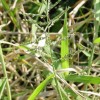 Paragrass (also referred to as Californiagrass) is thought to have been introduced into Florida sometime in the late 1870s as a forage plant. The semiaquatic grass is a native of tropical Africa, and today it is established in both hemispheres in tropical and subtropical regions as a highly palatable fodder. The grass is established in regions of poorly drained soils and along freshwater shorelines in Alabama, Florida, Hawaii, Maryland, Oregon, South Carolina, and Texas. It is an extremely aggressive competitor that can displace many shoreline emergent plants and plants in cultivated or disturbed sites associated with moist soil. Paragrass becomes readily established in wet soils along shorelines where it can form large monocultures. This 4-page fact sheet was written by L. T. Markle, B. A. Sellers, and W. A. Overholt, and published by the UF Department of Agronomy, April 2013.
Paragrass (also referred to as Californiagrass) is thought to have been introduced into Florida sometime in the late 1870s as a forage plant. The semiaquatic grass is a native of tropical Africa, and today it is established in both hemispheres in tropical and subtropical regions as a highly palatable fodder. The grass is established in regions of poorly drained soils and along freshwater shorelines in Alabama, Florida, Hawaii, Maryland, Oregon, South Carolina, and Texas. It is an extremely aggressive competitor that can displace many shoreline emergent plants and plants in cultivated or disturbed sites associated with moist soil. Paragrass becomes readily established in wet soils along shorelines where it can form large monocultures. This 4-page fact sheet was written by L. T. Markle, B. A. Sellers, and W. A. Overholt, and published by the UF Department of Agronomy, April 2013.
http://edis.ifas.ufl.edu/ag375
Cypress looper Anacamptodes pergracilis (Hulst) (Insecta: Lepidoptera: Geometridae) (EENY303/IN986)
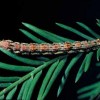 Anacamptodes pergracilis (Hulst), commonly known as the cypress looper, drew considerable attention in late summer of 1980 with the unexpected defoliation of nearly 28,000 ha of cypress trees in USFS-NPS Big Cypress National Preserve (Collier and Monroe counties). Currently, cypress looper populations are at low levels, even in the Fisheating Creek (Glades County) area, a perennial generator of significant cypress looper defoliation over the past 20 years. This 3-page fact sheet was written by Wayne N. Dixon, and published by the UF Department of Entomology and Nematology, April 2013.
Anacamptodes pergracilis (Hulst), commonly known as the cypress looper, drew considerable attention in late summer of 1980 with the unexpected defoliation of nearly 28,000 ha of cypress trees in USFS-NPS Big Cypress National Preserve (Collier and Monroe counties). Currently, cypress looper populations are at low levels, even in the Fisheating Creek (Glades County) area, a perennial generator of significant cypress looper defoliation over the past 20 years. This 3-page fact sheet was written by Wayne N. Dixon, and published by the UF Department of Entomology and Nematology, April 2013.
http://edis.ifas.ufl.edu/in986
Water Quality and the Effectiveness of Pesticides (PI245)
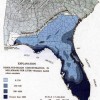 Pesticide applicators do not usually blame the mix for a pest control failure. Rather, the applicator will check if the correct pesticide was chosen for the job, if the pest was misidentified, if application equipment was properly calibrated, or if there was pesticide resistance. However, pesticide applicators should be aware that water quality can play a role in the efficacy of a pesticide treatment. Some pesticides lose their effectiveness when mixed with water that contains suspended or dissolved solids. This publication discusses how water quality affects pesticide mixes. This 2-page fact sheet was written by F. M. Fishel, and published by the UF Department of Agronomy, April 2013.
Pesticide applicators do not usually blame the mix for a pest control failure. Rather, the applicator will check if the correct pesticide was chosen for the job, if the pest was misidentified, if application equipment was properly calibrated, or if there was pesticide resistance. However, pesticide applicators should be aware that water quality can play a role in the efficacy of a pesticide treatment. Some pesticides lose their effectiveness when mixed with water that contains suspended or dissolved solids. This publication discusses how water quality affects pesticide mixes. This 2-page fact sheet was written by F. M. Fishel, and published by the UF Department of Agronomy, April 2013.
http://edis.ifas.ufl.edu/pi245
UF is celebrating Bug Week
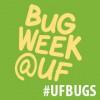 We at University of Florida want to provide you with a beginner-friendly yet science-based look at Florida’s bugs, with emphasis on the species that Florida residents and visitors often encounter. Some are Good Bugs. Some are Bad Bugs. And a whole lot are Bugly Bugs. Follow #UFBugs on Twitter, or vist the website at
We at University of Florida want to provide you with a beginner-friendly yet science-based look at Florida’s bugs, with emphasis on the species that Florida residents and visitors often encounter. Some are Good Bugs. Some are Bad Bugs. And a whole lot are Bugly Bugs. Follow #UFBugs on Twitter, or vist the website at
http://bugs.ufl.edu
Biting midges, no-see-ums Culicoides spp. (Insecta: Diptera: Ceratopogonidae) (EENY349/IN626)
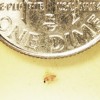 Biting midges can be a nuisance to campers, fishermen, hunters, hikers, gardeners, and others who spend time outdoors during early morning and evenings, and even during the daytime on cloudy days when winds are calm. They will readily bite humans; the bites are irritating, painful, and can cause long-lasting painful lesions for some people. A common observation upon experiencing a bite from this insect is that something is biting, but the person suffering can not see what it is. This 4-page fact sheet was written by C. Roxanne Connelly, and published by the UF Department of Entomology and Nematology, April 2013.
Biting midges can be a nuisance to campers, fishermen, hunters, hikers, gardeners, and others who spend time outdoors during early morning and evenings, and even during the daytime on cloudy days when winds are calm. They will readily bite humans; the bites are irritating, painful, and can cause long-lasting painful lesions for some people. A common observation upon experiencing a bite from this insect is that something is biting, but the person suffering can not see what it is. This 4-page fact sheet was written by C. Roxanne Connelly, and published by the UF Department of Entomology and Nematology, April 2013.
http://edis.ifas.ufl.edu/in626
Cornsilk Fly (suggested common name), Euxesta stigmatias Loew (Insecta: Diptera: Otitidae) (EENY224/IN381)
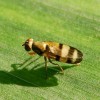 ‘Cornsilk flies’ are attractive, medium to dark metallic green to black colored flies with distinctive wing patterns and wing flapping behavior. They are commonly found throughout Florida’s agricultural communities. Their normally saprophytic life style belies their destructive nature when it comes to their preference for sweet corn ears. Four species of ‘cornsilk flies’ are known to attack corn in Florida: Chaetopsis massyla (Walker), Euxesta annonae (Fabricius), Euxesta eluta Loew, and Euxesta stigmatias Loew. This 8-page fact sheet was written by Gregg S. Nuessly and John L. Capinera, and published by the UF Department of Entomology and Nematology, April 2013. #UFBugs
‘Cornsilk flies’ are attractive, medium to dark metallic green to black colored flies with distinctive wing patterns and wing flapping behavior. They are commonly found throughout Florida’s agricultural communities. Their normally saprophytic life style belies their destructive nature when it comes to their preference for sweet corn ears. Four species of ‘cornsilk flies’ are known to attack corn in Florida: Chaetopsis massyla (Walker), Euxesta annonae (Fabricius), Euxesta eluta Loew, and Euxesta stigmatias Loew. This 8-page fact sheet was written by Gregg S. Nuessly and John L. Capinera, and published by the UF Department of Entomology and Nematology, April 2013. #UFBugs
http://edis.ifas.ufl.edu/in381
The mexican lac scale Tachardiella mexicana (Comstock) (Hemiptera: Kerriidae) (EENY552/IN990)
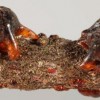 The Mexican lac scale is native to Mexico and Texas, but populations have been established in Florida. Adult female scales produce a high-domed ‘test’ or shell with four to six lobe-like projections that anchor the test to the plant surface. The test is hard and glossy with a reddish-orange tint around the edges, and darker toward the center. In some specimens, white string-like wax fiber extrusions project from the dorsum of the test, but these may break off. This 3-page fact sheet was written by Ian Stocks, and published by the UF Department of Entomology and Nematology, April 2013.
The Mexican lac scale is native to Mexico and Texas, but populations have been established in Florida. Adult female scales produce a high-domed ‘test’ or shell with four to six lobe-like projections that anchor the test to the plant surface. The test is hard and glossy with a reddish-orange tint around the edges, and darker toward the center. In some specimens, white string-like wax fiber extrusions project from the dorsum of the test, but these may break off. This 3-page fact sheet was written by Ian Stocks, and published by the UF Department of Entomology and Nematology, April 2013.
http://edis.ifas.ufl.edu/in990
Mealybug Vryburgia trionymoides (DeLotto) (Pseudococcidae) (EENY553/IN991)
 On several occasions in 2011, succulents for sale at retail stores in Florida were found with infestations of the mealybug Vryburgia trionymoides DeLotto. A traceback revealed that the succulents originated in California, where this mealybug is known as an occasional greenhouse pest. Specimens intercepted or found in retail stores often were well-hidden in the axillary region near the stem, making detection more challenging. An untreated infestation can kill a plant, there are no published reports of economic losses caused by this species. This 2-page fact sheet was written by Ian Stocks, and published by the UF Department of Entomology and Nematology, April 2013.
On several occasions in 2011, succulents for sale at retail stores in Florida were found with infestations of the mealybug Vryburgia trionymoides DeLotto. A traceback revealed that the succulents originated in California, where this mealybug is known as an occasional greenhouse pest. Specimens intercepted or found in retail stores often were well-hidden in the axillary region near the stem, making detection more challenging. An untreated infestation can kill a plant, there are no published reports of economic losses caused by this species. This 2-page fact sheet was written by Ian Stocks, and published by the UF Department of Entomology and Nematology, April 2013.
http://edis.ifas.ufl.edu/in991
Valuing the Ecosystem Services of Florida‹s Forest Conservation Programs: The Economic Benefits of Protecting Water Quality (FOR309/FR377)
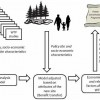 How much are Floridians willing to pay for water quality protection programs that include forest conservation? This 9-page fact sheet reports the results of a study to answer this question, using a benefit transfer approach. Written by Melissa M. Kreye, Francisco J. Escobedo, Damian C. Adams, Taylor Stein, and Tatiana Borisova, and published by the UF Department of School of Forest Resources and Conservation, April 2013.
How much are Floridians willing to pay for water quality protection programs that include forest conservation? This 9-page fact sheet reports the results of a study to answer this question, using a benefit transfer approach. Written by Melissa M. Kreye, Francisco J. Escobedo, Damian C. Adams, Taylor Stein, and Tatiana Borisova, and published by the UF Department of School of Forest Resources and Conservation, April 2013.
http://edis.ifas.ufl.edu/fr377
Common Woody Plants of Florida Scrub Ecosystems (FOR305/FR373)
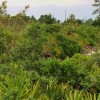 The purpose of this fact sheet is to help identify a few of the more common woody plant species found in Florida’s scrub ecosystems. In the individual plant descriptions, words that appear in bold font are considered to be key field characteristics that will aid in identification of the species. This 14-page fact sheet was written by Lynn Proenza and Michael Andreu, and published by the UF Department of School of Forest Resources and Conservation, October 2012.
The purpose of this fact sheet is to help identify a few of the more common woody plant species found in Florida’s scrub ecosystems. In the individual plant descriptions, words that appear in bold font are considered to be key field characteristics that will aid in identification of the species. This 14-page fact sheet was written by Lynn Proenza and Michael Andreu, and published by the UF Department of School of Forest Resources and Conservation, October 2012.
http://edis.ifas.ufl.edu/fr373
Citrus peelminer Marmara gulosa Guillèn and Davis (Insecta: Lepidoptera: Gracillariidae) (EENY415/IN985)
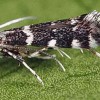 The citrus peelminer is a dark-gray moth with mottled white and brown markings and about 4 mm in length. This moth is considered native in the United States, attacking willow. It is believed that a host-shift occurred to multiple non-native plants including all varieties of citrus and cerain ornamentals, such as oleander. Citrus peelminer has been reported to occur in low numbers in Florida and at least three Marmara species have been identified in the state. Recent evaluations of an experimental pheromone lure that is still under development by researchers at the University of California, Riverside have confirmed captures of citrus peelminer (Marmara sp.) in Polk County, Florida. This 3-page fact sheet was written by Lukasz L. Stelinski, and published by the UF Department of Entomology and Nematology, April 2013.
The citrus peelminer is a dark-gray moth with mottled white and brown markings and about 4 mm in length. This moth is considered native in the United States, attacking willow. It is believed that a host-shift occurred to multiple non-native plants including all varieties of citrus and cerain ornamentals, such as oleander. Citrus peelminer has been reported to occur in low numbers in Florida and at least three Marmara species have been identified in the state. Recent evaluations of an experimental pheromone lure that is still under development by researchers at the University of California, Riverside have confirmed captures of citrus peelminer (Marmara sp.) in Polk County, Florida. This 3-page fact sheet was written by Lukasz L. Stelinski, and published by the UF Department of Entomology and Nematology, April 2013.
http://edis.ifas.ufl.edu/in985
Key to Nine Common Smilax Species of Florida (FOR307/FR375)
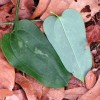 Identifying species found in Smilax the genus can be difficult because species resemble one another closely. One must be careful to use detailed descriptions in order to correctly identify a specimen. Smilax species are important because they can provide shelter and food for wildlife and have provided humans with medicine, food, and dyes. Twelve Smilax species are found in Florida. This 8-page fact sheet covers the nine more common species that one may encounter in the state. Written by Lynn Proenza and Michael Andreu, and published by the UF Department of School of Forest Resources and Conservation, January 2013.
Identifying species found in Smilax the genus can be difficult because species resemble one another closely. One must be careful to use detailed descriptions in order to correctly identify a specimen. Smilax species are important because they can provide shelter and food for wildlife and have provided humans with medicine, food, and dyes. Twelve Smilax species are found in Florida. This 8-page fact sheet covers the nine more common species that one may encounter in the state. Written by Lynn Proenza and Michael Andreu, and published by the UF Department of School of Forest Resources and Conservation, January 2013.
http://edis.ifas.ufl.edu/fr375
How Are the Reservoirs in the Apalachicola-Chattahoochee-Flint River Basin Managed? (AE497)
 Many uses of the Apalachicola-Chattahoochee-Flint river basin depend on how the US Army Corp of Engineers operates dam releases from the reservoirs when managing lake levels and downstream river flows and water levels. However, no single set of protocols equally suited to all uses and demands governs the reservoir releases. The purpose of this publication is to describe how the USACE manages reservoirs and dams in the ACF and how the waters in the basin are used. This 6-page fact sheet was written by Christopher J. Martinez, and published by the UF Department of Agricultural and Biological Engineering, March 2013.
Many uses of the Apalachicola-Chattahoochee-Flint river basin depend on how the US Army Corp of Engineers operates dam releases from the reservoirs when managing lake levels and downstream river flows and water levels. However, no single set of protocols equally suited to all uses and demands governs the reservoir releases. The purpose of this publication is to describe how the USACE manages reservoirs and dams in the ACF and how the waters in the basin are used. This 6-page fact sheet was written by Christopher J. Martinez, and published by the UF Department of Agricultural and Biological Engineering, March 2013.
http://edis.ifas.ufl.edu/ae497
Bagworm, Thyridopteryx ephemeraeformis Haworth (Insecta: Lepidoptera: Psychidae) (EENY548/IN981)
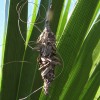 North American bagworm can feed on over 50 families of deciduous and evergreen trees and shrubs. Severe infestations can damage the aesthetics and health of host plants, especially juniper and arborvitae species. Many of the preferred host plants do not grow well below the USDA hardiness zone 8A, but due to its wide host range, high female fecundity, and method of dispersal, bagworm can still be problematic in the Florida landscape. This 5-page fact sheet was written by Brooke L. Moffis and Steven P. Arthurs, and published by the UF Department of Entomology and Nematology, March 2013.
North American bagworm can feed on over 50 families of deciduous and evergreen trees and shrubs. Severe infestations can damage the aesthetics and health of host plants, especially juniper and arborvitae species. Many of the preferred host plants do not grow well below the USDA hardiness zone 8A, but due to its wide host range, high female fecundity, and method of dispersal, bagworm can still be problematic in the Florida landscape. This 5-page fact sheet was written by Brooke L. Moffis and Steven P. Arthurs, and published by the UF Department of Entomology and Nematology, March 2013.
http://edis.ifas.ufl.edu/in981
EPA’s Endocrine Disruptor Screening Program (EDSP) (PI227)
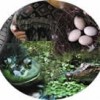 People have asked questions in recent years concerning the effects that certain chemicals may have on the endocrine system of humans and wildlife. Laboratory studies have produced evidence that show various chemicals disrupt the endocrine systems of animals. Other evidence has shown that the endocrine systems of certain fish and wildlife species have been affected by chemical contaminants. Do some of these same chemical contaminants also affect the human endocrine system? Do pesticides cause these effects? The relationship between human diseases of the endocrine system and exposure to environmental contaminants is poorly understood and controversial. This 2-page fact sheet discusses the U.S. Environmental Protection Agency’s (EPA) screening program for potential effects to the endocrine system caused by pesticide exposure. Written by F.M. Fishel, and published by the UF Department of Agronomy, March 2013.
People have asked questions in recent years concerning the effects that certain chemicals may have on the endocrine system of humans and wildlife. Laboratory studies have produced evidence that show various chemicals disrupt the endocrine systems of animals. Other evidence has shown that the endocrine systems of certain fish and wildlife species have been affected by chemical contaminants. Do some of these same chemical contaminants also affect the human endocrine system? Do pesticides cause these effects? The relationship between human diseases of the endocrine system and exposure to environmental contaminants is poorly understood and controversial. This 2-page fact sheet discusses the U.S. Environmental Protection Agency’s (EPA) screening program for potential effects to the endocrine system caused by pesticide exposure. Written by F.M. Fishel, and published by the UF Department of Agronomy, March 2013.
http://edis.ifas.ufl.edu/pi227
Blue Orchard Bee, Osmia lignaria Say (Insecta: Hymenoptera: Megachilidae) (EENY549/IN982)
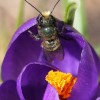 The blue orchard bee, Osmia lignaria Say (Fig. 1), is a solitary mason bee native to the west coast of the United States and Canada. It is of great interest for use as a native pollinator of fruit trees and blueberries, and is easily managed due to its favorable biological characteristics. Blue orchard bees can be purchased online for pollination, and they are shipped as pupae ready to emerge in the spring. This 4-page fact sheet was written by Alden Estep, Catherine Zettel-Nalen, and James Ellis, and published by the UF Department of Entomology and Nematology, March 2013.
The blue orchard bee, Osmia lignaria Say (Fig. 1), is a solitary mason bee native to the west coast of the United States and Canada. It is of great interest for use as a native pollinator of fruit trees and blueberries, and is easily managed due to its favorable biological characteristics. Blue orchard bees can be purchased online for pollination, and they are shipped as pupae ready to emerge in the spring. This 4-page fact sheet was written by Alden Estep, Catherine Zettel-Nalen, and James Ellis, and published by the UF Department of Entomology and Nematology, March 2013.
http://edis.ifas.ufl.edu/in982